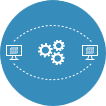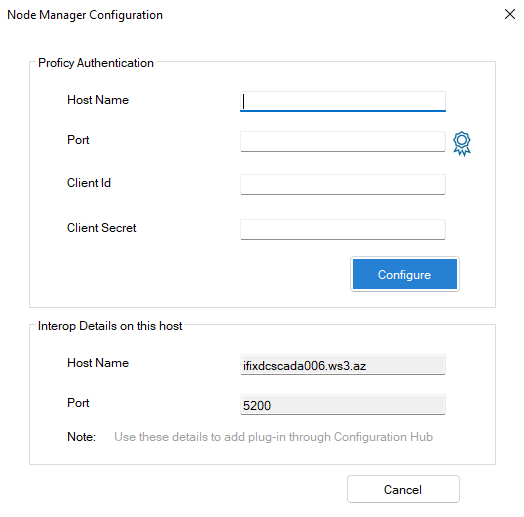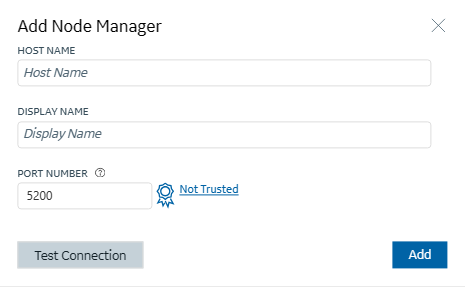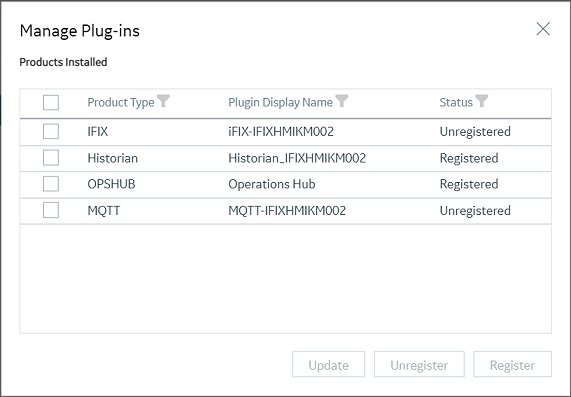iFIX Plugin Registration
The Node Manager Configuration Utility, which is installed during the iFIX install, allows you to register (in the case of an existing Configuration Hub), or re-register your iFIX product plugin with Configuration Hub when and if your setup changes. iFIX security must be enabled before you can register Configuration Hub.
The following sections describe how to use the Node Manager Configuration Utility.
Before you can Register Configuration Hub
- Make sure that users have been added in Windows, and that security is enabled on all of the iFIX SCADAs.
- Be aware that the Configuration Hub web server and the iFIX plugin ports must be allowed in the firewall exception rules during installation. If you do not do this during installation, you will need to add these applications manually to the firewall rules.
- If you are using Configuration Hub on a domain, you may need to update the HOSTS files on your network with the name of the Configuration Hub server, the iFIX SCADA Server, and Historian Server (if applicable).
- You can find the HOSTS file in the C:\WINDOWS\system32\drivers\etc folder.
- Depending upon your permissions, you may need to copy this file to another folder, edit it, and then copy it back to the etc folder after your edits are complete.
- Use a text editor such as Notepad to edit the HOSTS file. To prevent Notepad from automatically adding a .TXT file extension when you save the file, in the Save as Type field, select “All Files.”
- An example entry in the HOSTS file is as follows: 198.212.170.4 SCADA01. If SCADA1 was the iFIX SCADA Server node name, but the computer name where the iFIX SCADA Server was installed was AREA1, you would need to add a second line to the HOSTS file for AREA1: 198.212.170.4 AREA1.
- If you do not know the TCP/IP address of a computer, run the IPCONFIG command on the SCADA Server to obtain it.
- The contents of the HOSTS file should be identical on each node in your network.
- If your iFIX SCADA Server node name is different from the computer name where iFIX is installed, you also need to add this name to each HOSTS file.
- For Historian, you may need to use the fully qualified domain name (FQDN) in the hosts file of the Web client's machine so it can connect properly to the Configuration Hub machine.
Run the Node Manager Configuration Utility
- Use the desktop icon to run the Node Manager Configuration Utility
 with Administrator privileges.
with Administrator privileges.
- In the Proficy Authentication field, enter the Host Name of the Proficy Authentication server. Edit the value in the Port field if necessary. Enter the Client ID and Client Secret.
- Click the certificate icon
 to trust the certificate.
to trust the certificate. - Click Configure.
- Log into Configuration Hub to add the Node Manager.
- Expand the Administration menu in the Navigation panel.
- Click Node Manager. The Node Manager-Administration panel will open.
- Click the Add Node Manager button
 in the Node Manager-Administration pane. The Add
Node Manager dialog box will appear.
in the Node Manager-Administration pane. The Add
Node Manager dialog box will appear.
- Enter the Host Name, Display Name and Port.
- Click the Not Trusted link beside the certificate icon. The Certificate Details dialog will appear.
- Click Trust.
- Click Add. The node will appear in the node manager.

- In the Details pane, click
 to open the Manage Plug-ins dialog box.
to open the Manage Plug-ins dialog box. 
- Select the plug-in you want to register, and then click
Register. A message will appear at the top of the
page that the plug-in has registered successfully and the iFIX plug-in will now
appear in the navigation panel. Refresh the browser.

Login to Configuration Hub and Configure the User
You can now login to Configuration Hub with the ch_admin user. Use the client secret supplied when you installed Proficy Authentication as the password.
Add the scada.fix.shared.APPLICATION_DESIGNER group to the user for iFIX access in Configuration Hub access, and the scada.fix_shared_IFIX_PROFICY_AUTH_ADMIN group to provide access for to all iFIX features (iFIX administrator access).
Logout of Configuration Hub and log back in to start using iFIX features in Configuration Hub.
Descriptions of Fields Available in Registration Tool
The following fields appear in the Configuration Hub Registration tool:
| Field | Description |
|---|---|
| Server Name | The server's name for the Configuration Hub or Proficy Authentication server. When using a network domain,
provide the full domain name. You must supply valid current credentials (Client ID and secret) to register. |
| Server Port | Displays the port associated with the Configuration Hub or Proficy Authentication server. |
| Client ID | Displays the Client ID for your Configuration Hub or Proficy Authentication server. The Client ID and Client Secret was created when you installed the Configuration Hub product. |
| Client Secret | The client secret associated with the Configuration Hub or Proficy Authentication server. The Client ID and Client Secret was created when you installed the product. You will need to enter the Client Secret if you want to change the server's name (update), unregister, or register your Configuration Hub web server.Note: If you
forget your client ID or secret, you will not be able to
register/unregister plug-ins with Configuration Hub or Proficy
Authentication. In this case, you would need to reinstall Configuration Hub and/or Proficy
Authentication and register all of all the plug-ins again in
order to change them. |
| Use Configuration Hub Authentication Credentials for Proficy Authentication check box | Select this check box if you had entered same credentials (Client ID and Client Secret) for both Configuration Hub and Proficy Authentication during installation. |
| Update button | Click this button to save changes entered in this wizard. To save your changes, You must enter the Client ID and Client Secret information that you entered when you installed the product. |
| Register button | Click to register your Configuration Hub and Proficy Authentication server. This button is only available if the Configuration Hub or Proficy Authentication web server is in an unregistered state. To register Configuration Hub and Proficy Authentication , you'll need the Client ID and Client Secret information that you entered when you installed the product. |
| Unregister button | Click to unregister your Configuration Hub web server. This button is only available if the Configuration Hub or Proficy Authentication web server is in a registered state. To unregister Configuration Hub, you'll need the Client ID and Client Secret information that you entered when you installed the product. |